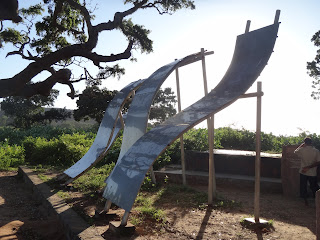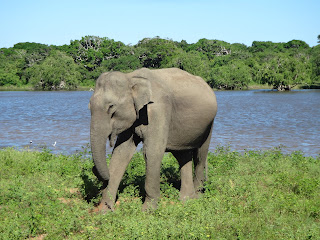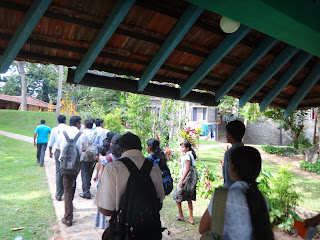 |
Adam's Peak
known locally as Sri Pada |
Adam's Peak is both an object of worship and pilgrimage for centuries for Hindus, Muslims, Buddhists and Christians alike. At the summit there is a huge boulder, about 8 ft high with strange impression on the bare rock that is claimed to be a footprint (Sri Pada) made by Buddha himself during the third of his three legendary visits to the island. The Christians believe that Adam, the father of the human race, was expelled from the Garden of Eden (Paradise) for eating the forbidden fruit and then cast back to earth, on top of this mountain where he stood on one foot for 1000 years to expiate his sin against the Creator. The Muslims have a similar belief to the Christians. They believe that the sepulcher of Adam lies atop the mountain. The Hindus believe that the footprint is that of Lord Siva, the 3rd god of the Holy Triad. What's really impressive to me is not the footprint itself, but the fact that this sacred place coveted by so many faiths is not wrapped up in a religious battle or turf war like those you find in places like Jerusalem.
The mountain itself is dramatic in that it rises abruptly from the lower valley with no other peaks around. It's not the highest mountain on the island, but it does offer an unobstructed view over the land and sea. We wanted to make our way to the summit before sunset to witness a unique phenomenon known as the irasevaya or "Shadow of the Peak". The rising sun casts a perfectly triangular shadow of the peak's summit, which hangs miraculously suspended in the air for about 20 minutes. The phenomenon has yet to be fully explained, thus the Buddhist take this as proof of Sri Pada's importance and supernatural quality.
 |
Scared for my life and holding on to the seat in front
of me. I mean, you can see my hair is even flying up..
that's how much we were bouncing around in the car! |
So off we go to make our own pilgrimage up Adam's Peak. The drive to Dalhousie, base of Adam's Peak was another terrifying drive despite the beauty of the tea plantations that surrounded us. The road was wide enough for one car and one motorcycle to fit side by side, but this was a 2-lane road apparently. Our driver, being aggressive as usual, was speeding around blind curves and honking to pass cars the entire way. The roads were full of potholes and rough edges, many of the edges dropped straight down the mountain side leaving no room for error. I was so nauseous and car sick- I came really close to throwing up and even had to open the window when I thought I was going to lose it. You know the road / drive is bad when Mollie can't sleep. That girl can sleep in any vehicle! But not this time... Holly and I both took a meclazine for the drive home.
 |
Tea plantations everywhere. The scenery was beautiful.
Too bad we were too scared to enjoy it. |
We finally got to our little hotel- Wathsala Inn, at the base of Adam's Peak. We watched the sunset over Adam's Peak from the patio and then after a delicious buffet with many new curries we attempted to get a few hours of sleep in before we got up at 2am to start our adventure. No such luck. Not only is it impossible for me to go to bed at 9pm, but buses were pulling up and tuk tuks were honking all night. The Russians in our hotel were celebrating someones birthday and of course were drinking heavily. They were so loud it sounded like they were in our room. I think I managed to fall asleep at 1:30am and then the alarm went off at 2. Sigh.
 |
| 2:30 am. Here we go. |
 |
| Sinhalese, Tamil, English |
We were on the road at 2:30 am, walking from our hotel to the base. You can't tell where the trail really begins because it is lined with food shops, souvenir stands, and lots of folks selling warm clothing. We specifically chose to go this weekend instead of last because last weekend was Poya Day, or full moon. Poya Day is sacred for the Buddhists (80% of Sri Lanka) and many make the pilgrimage up to the top to give their worship to Adam's footprint. All 12 Poya Days are public holidays so travel around the island is also greatly increased with people celebrating with family. Needless to say, we wanted to avoid
more vehicles on the road and
more crowding at a tourist attraction.
We hiked the from the base of Dalhousie on the northern side of the mountain. Over 5,000 stairs and 7437 feet of elevation the climb didn't take us nearly as long as we had anticipated, BUT, as we approached the top, we started to drastically slow down until we came to a halt. We were stuck in a cue of people. We were about 100m from the top and moving about 1 step per 10-15 min. It was only 4:30 in the morning and people were coming down the other side so we figured we still had 1.5-2 hours to go less than 100m. Wrong. Mollie and I only got about 50m from the top by 6am. The sun began to rise. We didn't move a single step. Luckily, we were stuck at a point on the east side of the mountain with a clear view of the valley and sun rise. It was spectacular. Such bright reds and oranges cast by the sun and a bright moon overhead lighting the mist over the reservoir at the base of the valley. You could see miles out and the mist continued to clear, the clouds lifted to form cotton balls around a lower segment of the mountain. What a gorgeous site to see. My pictures just don't do it justice.



 |
| So close to the top but not moving. |
I began to have some hope again as I started to see a stream of people starting their descent, however, our line continued to stand still. It was frustrating to see all the punk teenagers jumping the rails to go up the "down" side. These people were getting to the top while the rest of us were standing still. If they wouldn't have all cut the line, our line would actually move. I sound so old. But it was frustrating and disrespectful. We were so close, but the top was so jammed up with people going up through the exits (there are 3 trails on different sides of the mountain that lead to the top) and to top it off, Adam's foot print was closed off so we wouldn't be able to see it anyways. All in all, we stood stationary 50m from the top for 2.5 hours. TWO AND A HALF HOURS! We had met a nice British couple on their honeymoon in line behind us and we were all able to keep ourselves entertained, but when we spoke with a European couple on their way down who told us it wasn't worth it, we decided to give in and start heading down to find Holly. We were freezing and frustrated. We also knew that Holly hadn't packed as many warm clothes as we had so if we were cold, she had to be freezing. Enough was enough.
We found Holly on our way down. She was also stuck in the line and ended up with a group of French tourists so she got a chance to practice her French! Since she had packed fewer warm clothes, she was freezing and hoping we'd come down soon.
The way down is always worse than the way up. Some stairs were wide, some skinny, some narrow, some high, some short, you get the point! The hike was much more beautiful on the way up- in the dark. It was actually very sad to see just how poorly the Sri Lankan people, particularly the youth, treat this supposedly sacred trail. People were peeing in the bushes despite having toilets every hundred meters. We watched locals- both old and young- throwing their trash anywhere they pleased. The bushes, the stairs, everywhere! Guess the concept of "leave no trace" hasn't made it's way here. They are also burning their trash along the trail- plastic and all. Really makes for some good air quality when sucking wind on your way up!
 |
Coming down with the clear blue skies
and the moon above. |
 |
| Down, down, down we go. |
It was really quite sad that the foreigners treat Adam's Peak with more respect than the locals who cherish Sri Pada as a sacred pilgrimage.
Climbing Adam's Peak was a great experience and a gorgeous sun rise, but next time I'd avoid the harassment by adolescents with all their pushing and shoving, avoid the line and overall trashed staircase, and opt instead to climb Sigiryia. After all, Adam's Peak is only the 4th tallest mountain in Sri Lanka so it's nothing to brag about :-)










































